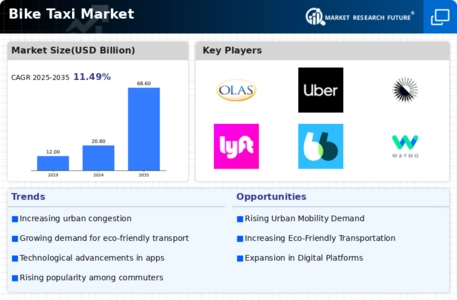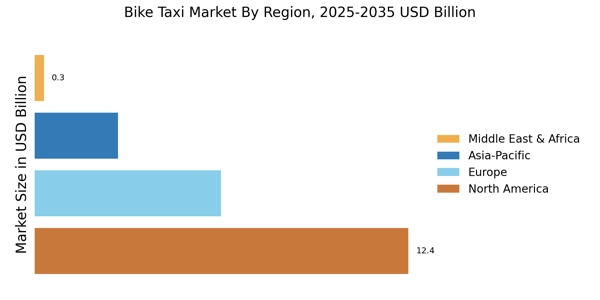Rising Urbanization
The increasing trend of urbanization is a pivotal driver for the Bike Taxi Market. As more individuals migrate to urban areas, the demand for efficient and cost-effective transportation solutions escalates. Urban centers often face congestion, making traditional transport methods less viable. In this context, bike taxis emerge as a practical alternative, offering quick and flexible mobility. According to recent data, urban areas are projected to house over 68% of the world's population by 2050, further amplifying the need for innovative transport solutions. This shift not only enhances the appeal of bike taxis but also positions them as a sustainable option in densely populated regions, thereby fostering growth in the Bike Taxi Market.
Government Initiatives
Government initiatives aimed at promoting sustainable transportation are playing a crucial role in the Bike Taxi Market. Many governments are implementing policies that encourage the use of eco-friendly transport options, including bike taxis. Incentives such as subsidies, tax breaks, and infrastructure development for cycling paths are becoming more common. For instance, recent reports indicate that several countries are investing in cycling infrastructure to support the growth of bike-sharing and taxi services. These initiatives not only enhance the viability of bike taxis but also contribute to a broader shift towards sustainable urban mobility. As governments continue to prioritize green transport solutions, the Bike Taxi Market is poised for substantial growth.
Environmental Awareness
Growing environmental consciousness among consumers is significantly influencing the Bike Taxi Market. As awareness of climate change and pollution rises, individuals are increasingly seeking eco-friendly transportation options. Bike taxis, which produce lower emissions compared to traditional vehicles, align with this shift towards sustainability. Recent studies indicate that the transportation sector accounts for nearly 24% of global CO2 emissions, prompting a search for greener alternatives. The Bike Taxi Market stands to benefit from this trend, as more consumers opt for services that contribute to reducing their carbon footprint. This heightened focus on environmental impact is likely to drive demand for bike taxis, positioning them as a preferred choice for environmentally conscious commuters.
Technological Advancements
Technological innovations are reshaping the Bike Taxi Market, enhancing operational efficiency and customer experience. The integration of mobile applications for booking and payment has streamlined the process, making bike taxis more accessible to users. Furthermore, advancements in GPS technology enable real-time tracking, ensuring safety and convenience for riders. Data from recent surveys suggests that over 60% of consumers prefer using apps for transportation services, indicating a strong market inclination towards tech-driven solutions. As technology continues to evolve, the Bike Taxi Market is likely to witness increased adoption rates, as both riders and operators benefit from improved service delivery and operational management.
Changing Consumer Preferences
Shifting consumer preferences towards convenience and flexibility are driving the Bike Taxi Market. Modern consumers increasingly favor on-demand services that cater to their immediate transportation needs. Bike taxis offer a unique solution, providing quick and efficient rides without the hassle of parking or long wait times. Recent market analysis reveals that the demand for on-demand transport services has surged, with bike taxis emerging as a popular choice among urban commuters. This trend is particularly pronounced among younger demographics, who prioritize convenience and sustainability in their travel choices. As consumer preferences continue to evolve, the Bike Taxi Market is likely to expand, adapting to meet the needs of a dynamic market.

















